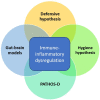Examining the Relationships between the Incidence of Infectious Diseases and Mood Disorders: An Analysis of Data from the Global Burden of Disease Studies, 1990-2019
- PMID: 37754312
- PMCID: PMC10528187
- DOI: 10.3390/diseases11030116
Examining the Relationships between the Incidence of Infectious Diseases and Mood Disorders: An Analysis of Data from the Global Burden of Disease Studies, 1990-2019
Abstract
Mood disorders are among the commonest mental disorders worldwide. Epidemiological and clinical evidence suggests that there are close links between infectious diseases and mood disorders, but the strength and direction of these association remain largely unknown. Theoretical models have attempted to explain this link based on evolutionary or immune-related factors, but these have not been empirically verified. The current study examined cross-sectional and longitudinal associations between the incidence of infectious diseases and mood disorders, while correcting for climate and economic factors, based on data from the Global Burden of Disease Studies, 1990-2019. It was found that major depressive disorder was positively associated with lower respiratory infections, while bipolar disorder was positively associated with upper respiratory infections and negatively associated with enteric and tropical infections, both cross-sectionally and over a period of 30 years. These results suggest that a complex, bidirectional relationship exists between these disorders. This relationship may be mediated through the immune system as well as through the gut-brain and lung-brain axes. Understanding the mechanisms that link these groups of disorders could lead to advances in the prevention and treatment of both.
Keywords: bipolar disorder; gut–brain axis; infectious diseases; lower respiratory infectious; lung–brain axis; major depressive disorder; upper respiratory infections.
Conflict of interest statement
The author declares no conflict of interest.
Figures
Similar articles
-
Letter to the Editor: CONVERGENCES AND DIVERGENCES IN THE ICD-11 VS. DSM-5 CLASSIFICATION OF MOOD DISORDERS.Turk Psikiyatri Derg. 2021;32(4):293-295. doi: 10.5080/u26899. Turk Psikiyatri Derg. 2021. PMID: 34964106 English, Turkish.
-
Nutrition-based interventions for mood disorders.Expert Rev Neurother. 2021 Mar;21(3):303-315. doi: 10.1080/14737175.2021.1881482. Epub 2021 Mar 3. Expert Rev Neurother. 2021. PMID: 33487078
-
Right care, first time: a highly personalised and measurement-based care model to manage youth mental health.Med J Aust. 2019 Nov;211 Suppl 9:S3-S46. doi: 10.5694/mja2.50383. Med J Aust. 2019. PMID: 31679171
-
Advances in the gut microbiome and mood disorders.Curr Opin Psychiatry. 2023 Jan 1;36(1):1-7. doi: 10.1097/YCO.0000000000000829. Curr Opin Psychiatry. 2023. PMID: 36131643 Review.
-
Current Understanding of Gut Microbiota in Mood Disorders: An Update of Human Studies.Front Genet. 2019 Feb 19;10:98. doi: 10.3389/fgene.2019.00098. eCollection 2019. Front Genet. 2019. PMID: 30838027 Free PMC article. Review.
References
-
- World Health Organization . Depression and Other Common Mental Disorders: Global Health Estimates. World Health Organization; Geneva, Switzerland: 2017.
-
- GBD 2019 Mental Disorders Collaborators Global, regional, and national burden of 12 mental disorders in 204 countries and territories, 1990–2019: A systematic analysis for the Global Burden of Disease Study 2019. Lancet Psychiatry. 2022;9:137–150. doi: 10.1016/S2215-0366(21)00395-3. - DOI - PMC - PubMed
-
- Judd L.L., Schettler P.J., Solomon D.A., Maser J.D., Coryell W., Endicott J., Akiskal H.S. Psychosocial disability and work role function compared across the long-term course of bipolar I, bipolar II and unipolar major depressive disorders. J. Affect. Disord. 2008;108:49–58. doi: 10.1016/j.jad.2007.06.014. - DOI - PubMed
-
- Ratheesh A., Davey C., Hetrick S., Alvarez-Jimenez M., Voutier C., Bechdolf A., McGorry P.D., Scott J., Berk M., Cotton S.M. A systematic review and meta-analysis of prospective transition from major depression to bipolar disorder. Acta Psychiatr. Scand. 2017;135:273–284. doi: 10.1111/acps.12686. - DOI - PubMed
LinkOut - more resources
Full Text Sources



